PLANET VGW-400FO User Manual

4-Port SIP Internet
Telephony Gateway
 VGW-402 / VGW-400FS / VGW-400FO
VGW-402 / VGW-400FS / VGW-400FO

4-Port SIP Internet Telephony Gateway
VGW-400 Series
Copyright
Copyright© 2014 by PLANET Technology Corp. All rights reserved. No part of this publication may be reproduced, transmitted, transcribed, stored in a retrieval system, or translated into any language or computer language, in any form or by any means, electronic, mechanical, magnetic, optical, chemical, manual or otherwise, without the prior written permission of PLANET. PLANET makes no representations or warranties, either expressed or implied, with respect to the contents hereof and specifically disclaims any warranties, merchantability or fitness for any particular purpose. Any software described in this manual is sold or licensed "as is". Should the programs prove defective following their purchase, the buyer (and not this company, its distributor, or its dealer) assumes the entire cost of all necessary servicing, repair, and any incidental or consequential damages resulting from any defect in the software. Further, this company reserves the right to revise this publication and to make changes from time to time in the contents hereof without obligation to notify any person of such revision or changes. All brand and product names mentioned in this manual are trademarks and/or registered trademarks of their respective holders.
Disclaimer
PLANET Technology does not warrant that the hardware will work properly in all environments and applications, and makes no warranty and representation, either implied or expressed, with respect to the quality, performance, merchantability, or fitness for a particular purpose. PLANET has made every effort to ensure that this User’s Manual is accurate; PLANET disclaims liability for any inaccuracies or omissions that may have occurred. Information in this User’s Manual is subject to change without notice and does not represent a commitment on the part of PLANET. PLANET assumes no responsibility for any inaccuracies that may be contained in this User’s Manual. PLANET makes no commitment to update or keep current the information in this User’s Manual, and reserves the right to make improvements in this User’s Manual and/or to the products described in this User’s Manual, at any time without notice. If you find information in this manual that is incorrect, misleading, or incomplete, we would appreciate your comments and suggestions.
Trademarks
The PLANET logo is a trademark of PLANET Technology. This documentation may refer to numerous hardware and software products by their trade names. In most, if not all cases, these designations are claimed as trademarks or registered trademarks by their respective companies.
CE Mark Warning
This is a class B device, in a domestic environment; this product may cause radio interference, in which case the user may be required to take adequate measures.
Federal Communication Commission Interference Statement
This equipment has been tested and found to comply with the limits for a Class B digital device, pursuant to Part 15 of FCC Rules. These limits are designed to provide reasonable protection against
2

4-Port SIP Internet Telephony Gateway
VGW-400 Series
harmful interference in a residential installation. This equipment generates, uses, and can radiate radio frequency energy and, if not installed and used in accordance with the instructions, may cause harmful interference to radio communications. However, there is no guarantee that interference will not occur in a particular installation. If this equipment does cause harmful interference to radio or television reception, which can be determined by turning the equipment off and on, the user is encouraged to try to correct the interference by one or more of the following measures:
1.Reorient or relocate the receiving antenna.
2.Increase the separation between the equipment and receiver.
3.Connect the equipment into an outlet on a circuit different from that to which the receiver is connected.
4.Consult the dealer or an experienced radio technician for help.
FCC Caution:
To assure continued compliance, for example, use only shielded interface cables when connecting to computer or peripheral devices. Any changes or modifications not expressly approved by the party responsible for compliance could void the user’s authority to operate the equipment. This device complies with Part 15 of the FCC Rules. Operation is subject to the following two conditions: (1) This device may not cause harmful interference, and (2) this device must accept any interference received, including interference that may cause undesired operation.
R&TTE Compliance Statement
This equipment complies with all the requirements of DIRECTIVE 1999/5/EC OF THE EUROPEAN PARLIAMENT AND THE COUNCIL OF 9 March 1999 on radio equipment and telecommunication terminal Equipment, and the mutual recognition of their conformity (R&TTE). The R&TTE Directive repeals and replaces in the directive 98/13/EEC (Telecommunications Terminal Equipment and Satellite Earth Station Equipment) as of April 8, 2000.
WEEE Caution
To avoid the potential effects on the environment and human health as a result of the presence of hazardous substances in electrical and electronic equipment, end users of electrical and electronic equipment should understand the meaning of the crossed-out
wheeled bin symbol. Do not dispose of WEEE as unsorted municipal waste and have to collect such WEEE separately.
3

4-Port SIP Internet Telephony Gateway
VGW-400 Series
Safety
This equipment is designed with the utmost care for the safety of those who install and use it. However, special attention must be paid to the dangers of electric shock and static electricity when working with electrical equipment. All guidelines of this and of the computer manufacture must therefore be allowed at all times to ensure the safe use of the equipment.
Customer Service
For information on customer service and support for Planet Products, please refer to the following Website URL: http://www.planet.com.tw
Before contacting customer service, please take a moment to gather the following information:
•Internet Telephony Gateway System serial number and MAC address
•Any error messages that displayed when the problem occurred
•Any software running when the problem occurred
•Steps you took to resolve the problem on your own
Revision
User’s Manual for PLANET Internet Telephony Gateway
Model: VGW-400 Series
Rev: 1.1 (January, 2014)
4

|
4-Port SIP Internet Telephony Gateway |
|
|
|
VGW-400 Series |
TABLE OF CONTENTS |
|
|
Chapter 1 Introduction ................................................................................................................. |
7 |
|
1.1 |
Features ........................................................................................................................................... |
10 |
1.2 |
Package Contents ............................................................................................................................ |
12 |
1.3 |
Physical Specifications.................................................................................................................... |
12 |
1.4 |
Specifications .................................................................................................................................. |
14 |
Chapter 2 Installation Procedure............................................................................................... |
20 |
|
2.1 Web Login ....................................................................................................................................... |
20 |
|
2.2 |
Configuring the Network Setting .................................................................................................... |
21 |
2.3 |
Changing IP Address or Forgotten Admin Password ...................................................................... |
22 |
Chapter 3 Device Setting ........................................................................................................... |
23 |
|
3.1 |
Network Configuration ................................................................................................................... |
23 |
3.2 |
Device Time Setting ........................................................................................................................ |
25 |
3.3 |
Device Advance Setting .................................................................................................................. |
27 |
3.4 |
User Login Setting .......................................................................................................................... |
27 |
3.5 |
Debug Setting.................................................................................................................................. |
28 |
3.6 |
Event Notice.................................................................................................................................... |
29 |
3.7 Auto Provisioning............................................................................................................................ |
29 |
|
3.8 SNMP.............................................................................................................................................. |
30 |
|
3.9 PABX Mode .................................................................................................................................... |
31 |
|
Chapter 4 NAT Setting................................................................................................................ |
33 |
|
4.1 |
DHCP Srv. (DHCP Server).............................................................................................................. |
33 |
4.2 |
UPNP (Universal Plug and Play Server) ......................................................................................... |
33 |
4.3 |
Bandwidth (Bandwidth Control) ..................................................................................................... |
34 |
4.4 |
URL Filter ....................................................................................................................................... |
38 |
4.5 |
IP Filter............................................................................................................................................ |
38 |
4.6 |
MAC Filter ...................................................................................................................................... |
38 |
4.7 APP Filter ........................................................................................................................................ |
39 |
|
4.8 |
Port Filter ........................................................................................................................................ |
39 |
4.9 |
Port Fwd .......................................................................................................................................... |
39 |
Chapter 5 VoIP Setting ............................................................................................................... |
40 |
|
5.1 |
SIP ................................................................................................................................................... |
40 |
5.2 Audio ............................................................................................................................................... |
41 |
|
5.3 Tone................................................................................................................................................. |
42 |
|
5.4 |
NAT Traversal ................................................................................................................................. |
43 |
Chapter 6 VoIP Advance............................................................................................................. |
44 |
|
5

|
4-Port SIP Internet Telephony Gateway |
|
|
|
VGW-400 Series |
6.1 |
SIP ................................................................................................................................................... |
44 |
6.2 |
SIP ................................................................................................................................................... |
47 |
6.3 |
Ring................................................................................................................................................. |
49 |
Chapter 7 Dialing Plan ............................................................................................................... |
50 |
|
7.1 |
General ............................................................................................................................................ |
50 |
7.2 |
Dialing Rule .................................................................................................................................... |
50 |
7.3 |
Digit Manipulation .......................................................................................................................... |
52 |
7.4 |
Phone Book ..................................................................................................................................... |
53 |
Chapter 8 FXS Setting................................................................................................................ |
54 |
|
8.1 |
FXS Line ......................................................................................................................................... |
54 |
8.2 |
SIP Proxy......................................................................................................................................... |
57 |
8.3 |
Caller ID.......................................................................................................................................... |
58 |
8.4 |
Others .............................................................................................................................................. |
59 |
Chapter 9 FXO Setting ............................................................................................................... |
60 |
|
9.1 |
FXO line.......................................................................................................................................... |
60 |
Chapter 10 SIP Trunk.................................................................................................................. |
63 |
|
10.1 Create SIP Trunk ........................................................................................................................... |
63 |
|
Chapter 11 Route Plan ............................................................................................................... |
67 |
|
11.1 For PABX Mode Interface............................................................................................................. |
67 |
|
11.2 For Non-PABX Mode Interface..................................................................................................... |
72 |
|
Chapter 12 Status ....................................................................................................................... |
76 |
|
12.1 Device Status................................................................................................................................. |
76 |
|
12.2 Line Status..................................................................................................................................... |
76 |
|
12.3 SIP Trunk Status............................................................................................................................ |
77 |
|
Chapter 13 Maintenance ............................................................................................................. |
78 |
|
13.1 Firmware Update........................................................................................................................... |
78 |
|
Appendix A – Default Setting..................................................................................................... |
79 |
|
Appendix B - Changing IP Address or Forgotten Admin Password ...................................... |
80 |
|
6

4-Port SIP Internet Telephony Gateway
VGW-400 Series
Chapter 1 Introduction
Cost-effective, High-performance PoE VoIP Phone
To build high-performance VoIP communications at a low cost, PLANET now introduces the latest member of its gateway family, the VGW-400 enterprise-class 4-port SIP VoIP Gateway series. The VGW-400 series provides added flexibility during migration to Unified Communications by supporting the traditional analog devices. These devices include analog phones, fax machines, modems, voicemail systems, and speakerphones. It helps the company to save money on long-distance calls; for example, the remote workers can dial in through a Unified VoIP Communication System just like an extension call but no long-distance call charge would occur. The VGW-400 series also allows call to be transferred to anyone at any location within the voice system, which enables the enterprise to communicate more effectively and is helpful to streamline business processes.
Standard Compliance
The VGW-400 series supports Session Initiation Protocol 2.0 (RFC 3261) for easy integration with general voice over IP system. The VGW-400 series is able to broadly interoperate with equipment provided by VoIP infrastructure providers, thus enabling them to provide their customers with better multi-media exchange services.
7
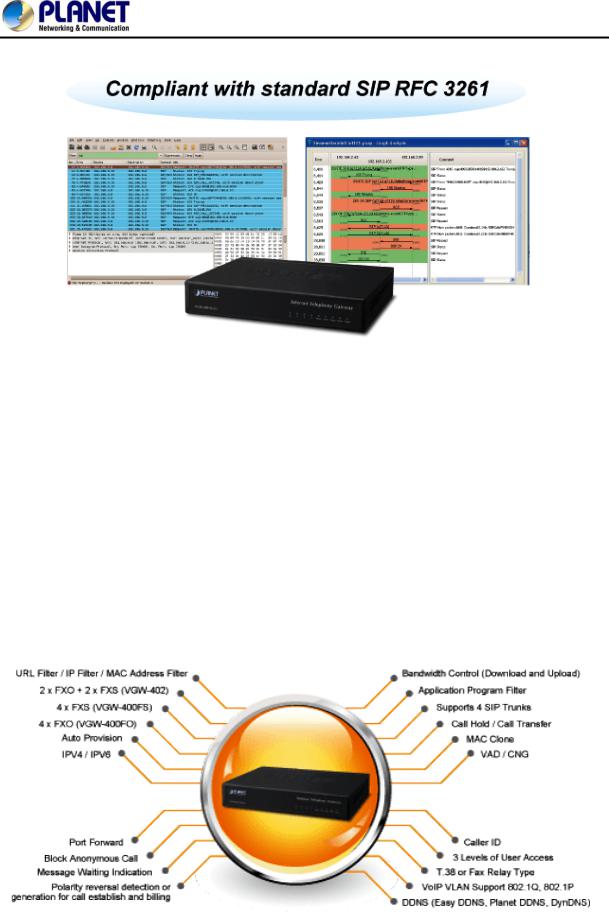
4-Port SIP Internet Telephony Gateway
VGW-400 Series
Enhanced, Full-Featured Business Gateway
The VGW-400 series is a full-featured enhanced business SIP Gateway that addresses the communication needs of the enterprises. It provides the FXO and FXS gateway with SIP protocol IP device which allows connection with PSTN telephone line and with analog telephone set to make or receive VoIP call over Internet or VPN network. This device is suitable for office PABX to enable to have VoIP call without changing cabling, dial plan and extension number.
The VGW-400 series supports all kinds of SIP-based gateway features and multiple contact filter functions, such as 4 SIP trunk accounts, both IPv6 and IPv4 protocols, flexible dial plan and route plan features, and switch analog and VoIP signal to help both protocols to communicate.
8
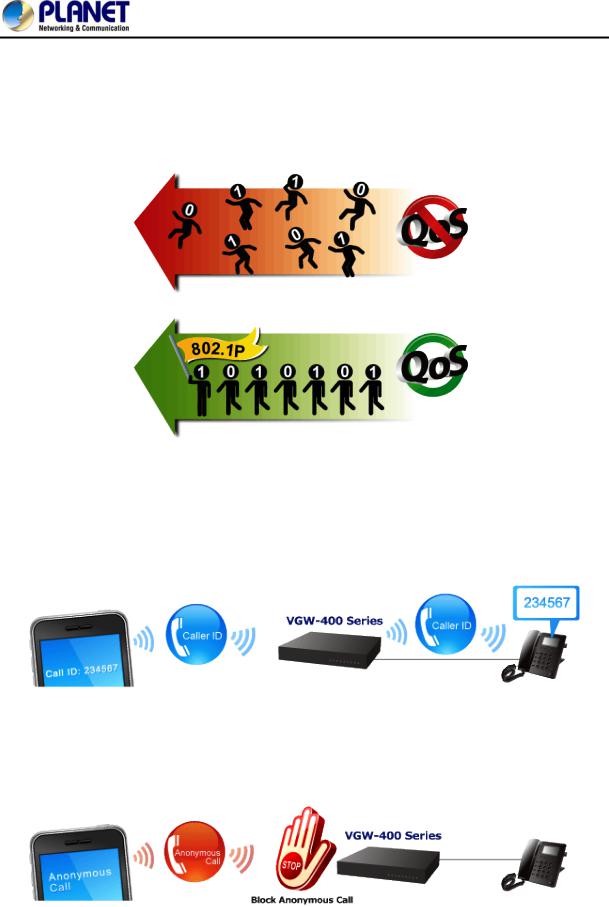
4-Port SIP Internet Telephony Gateway
VGW-400 Series
Secure, High-Quality VoIP Communication
It can effortlessly deliver secured toll voice quality by utilizing cutting-edge 802.1p QoS (Quality of Service), 802.1Q VLAN tagging, and IP TOS (Type of Service) technology. Using voice and data VLAN can easily separate the data and voice, thus maintaining the best quality.
Supporting Caller ID
Both the FXS and FXO ports of the VGW-400 series support caller ID function, help user identify calling number easily and verify number. It also helps to block anonymous call by filtering strange calls. The FXS port transmits Caller ID, while the FXO port receives Caller ID. The Caller ID interoperates with analog phones, public switched telephone networks (PSTN) and private branch exchanges (PBXs).
9

4-Port SIP Internet Telephony Gateway
VGW-400 Series
1.1 Features
¾Highlights
Supports SIP 2.0 (RFC3261)
Supports IPv6 and IPv4 simultaneously
Up to 4 SIP service domains and Caller ID
Supports auto HTTP provision and fax feature
Flexible Routes Plan, Dial Plan and SIP Trunk
Life-line for emergency calls
¾Internet Features
IPv4 (RFC 791) and IPv6
IPv6 auto configuration (RFC 4862)
IPv6 only, IPv4 only or dual stack
MAC clone setting
Vendor Class ID
DDNS ( Planet DDNS, Easy DDNS, DynDNS)
DNS client
Firewall
URL / IP / MAC / Port Filter
Port forwarding (TCP, UDP or both)
Bandwidth control (download and upload), maximum bandwidth priority setting
¾SIP Applications
SIP Session Timer (RFC 4028)
SIP Session Refresher: UAC or UAS
SIP Encryption
Supports Outbound Proxy / STUN NAT Traversal
Supports Primary and Backup SIP Server
¾Call Features
Supports peer to peer dialing
2-line FXO connects to PSTN line
2-line FXS connects to analog phone set or PABX.
Caller ID recognition DTMF (before/after 1st ring) and FSK (before 1st ring ), ETSI and Bellcore
DTMF Caller ID start and stop BIT configurable
T.38 fax volume configuration
10

4-Port SIP Internet Telephony Gateway
VGW-400 Series
¾FXO/FXS Line Configuration
Line ID / Line Phone number
Polarity Reversal detection or generation for call establish and billing
VoIP dial to FXO/PSTN Line: 1 stage dialing and 2 stage dialing
Outgoing SIP Caller ID selection
Caller ID detection mode by country selection
¾Routing Plan
Prefix match and length
Priority / Cyclic / Simultaneous Ring
Programmable Hunting Cycle
11
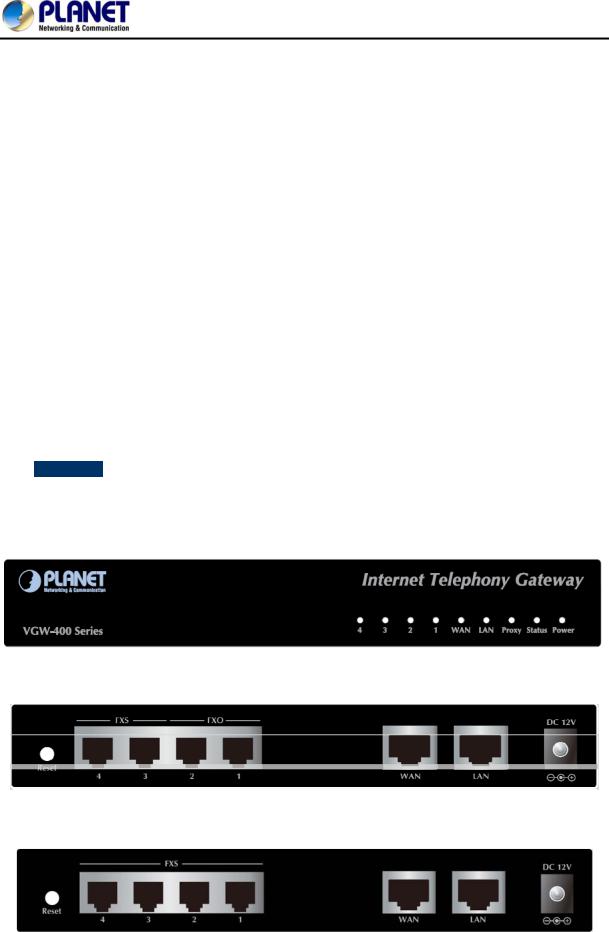
4-Port SIP Internet Telephony Gateway
VGW-400 Series
1.2 Package Contents
Thank you for purchasing PLANET Internet Telephony Gateway system, the VGW-400 series. This Quick Installation Guide will introduce how to finish the basic setting of connecting the web management interface and the Internet. Open the box of the Internet Telephony Gateway system and carefully unpack it. The box should contain the following items:
zVGW-400 Series x 1
zQuick Installation Guide x 1
zUser’s Manual CD x 1
zPower Adapter x 1 (12V)
zRJ-45 x 1
If any of the above items are damaged or missing, please contact your dealer immediately.
1.3 Physical Specifications
¾ Dimensions
Dimensions |
175 x 32 x126 mm |
|
|
Weight |
550g |
|
|
Front Panel of the VGW-400 Series
Rear Panel of the VGW-400 Series (VGW-402)
Rear Panel of the VGW-400 Series (VGW-400FS)
12
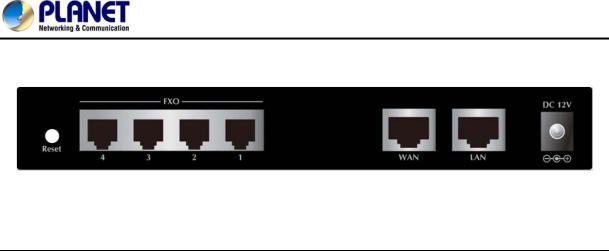
4-Port SIP Internet Telephony Gateway
VGW-400 Series
Rear Panel of the VGW-400 Series (VGW-400FO)
LED definitions
|
LED |
|
Function Description |
|
|
|
|
|
Power |
|
When the power adapter is connected, the LED will light up green. |
|
|
|
|
|
Status |
|
When system startup successfully, the LED will light up green. |
|
Proxy |
|
When the gateway is registered successfully to a SIP Proxy, this will |
|
|
light up green. |
|
|
|
|
|
|
|
|
|
|
|
|
This LED lights up green when the gateway’s WAN port is physically |
|
WAN |
|
connected to the public internet. When data is transmitted through |
|
|
|
this port, it will flash green. |
|
|
|
This LED lights up green when the gateway’s LAN port is physically |
|
LAN |
|
connected to a local network (Refer to Rear Panel section). When data |
|
|
|
is transmitted through this port, it will flash green. |
|
|
|
|
|
|
|
The status LED for FXO and FXS ports will light up amber orange when |
|
Port 1 - 4 |
|
connected phone is engaged in a conversation mode (FXO). It will |
|
|
|
flash amber orange when there is an incoming call (FXS). |
|
|
|
|
|
Port |
|
|
Function Description |
|
|
|
|
|
|
|
|
Reset |
|
Press and hold over 5 seconds to reload factory default setting, |
||
|
|
which will erase all existing settings configured on this gateway. |
|||
|
|
|
|
||
|
|
|
|
|
|
|
|
|
|
The status LED for FXS port, will light up amber orange when the |
|
|
FXS Ports |
|
|
connected phone’s handset is lifted, or when the connected phone is |
|
|
|
|
engaged in a conversation. It will flash amber orange when there |
|
|
|
|
|
|
|
|
|
|
|
|
is an incoming call. |
|
|
|
|
|
The status LED for FXO port will remind you that there is no PSTN |
|
|
FXO Ports |
|
line connected. When PSTN line is connected and there is no |
||
|
|
talking, the LED is OFF. When a line is using, the LED becomes |
|||
|
|
|
|
||
|
|
|
|
steadily light up. |
|
|
|
|
|
|
|
13
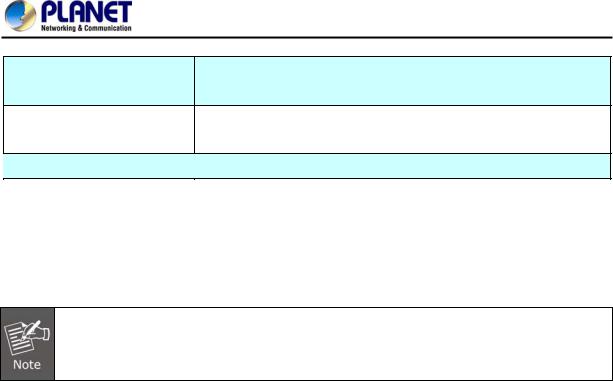
4-Port SIP Internet Telephony Gateway
VGW-400 Series
LAN
WAN
DC 12V
10/100Base-TX RJ-45 socket for LAN port connects to PC for management purposes.
10/100Base-TX RJ-45 socket for WAN port connects to wide area network.
The power socket, input AC 100V~240V; output DC12V, 1.5A
Button |
Action |
Description |
|
|
|
|
|
Reset |
Press less than 5 secs |
System reboot |
|
|
|
||
Press over 5 secs |
Reset to Factory Default |
||
|
|||
|
|
|
Please be reminded to reset to factory default. Uploaded music setting (on hold music) and backup file will not be removed.
1.4 Specifications
|
|
|
Product |
|
VGW-400 Series |
|
|
|
|
|
|
Hardware |
|
|
|
|
|
WAN |
|
1 x 10/100Mbps RJ-45 port |
|
|
|
|
|
|
LAN |
|
1 x 10/100Mbps RJ-45 port |
|
|
|
|
|
|
|
|
4 x RJ-11 connection |
Voice |
|
(VGW-402: 2 x FXS, 2 x FXO) |
|
(VGW-400FS: 4 x FXS) |
|
|
|
|
|
|
(VGW-400FO: 4 x FXO) |
|
|
|
Protocols and Standard |
|
|
|
|
|
|
|
IPv4 (RFC 791) and IPv6 |
|
|
IPv6 auto configuration (RFC 4862) |
|
|
IPv6 only, IPv4 only or dual stack |
|
|
MAC address (IEEE 802.3) |
|
|
MAC clone setting |
Data Networking |
|
Vendor Class ID |
|
|
IP / ICMP / ARP / RARP / SNTP |
|
|
Static IP |
|
|
DHCP Client (RFC 2131), WAN port |
|
|
DHCP Server, LAN port |
|
|
NAT Server (RFC 1631) |
|
|
|
14

4-Port SIP Internet Telephony Gateway
VGW-400 Series
Voice Gateway
PPPoE Client / DNS Client / TFTP Client DDNS (Planet DDNS, Easy DDNS, DynDNS) Firewall
URL / IP / MAC / Port Filter
Application Program Filter
Port Forwarding (TCP, UDP or both)
Bandwidth control (download and upload), maximum bandwidth priority setting
UPnP Server at LAN port
Behind NAT, use DMZ for NAT traversal SNTP with time zone and Daylight Saving
TCP/UDP (RFC 793/768), RTP/RTCP (RFC 1889/1890), IPV4 ICMP (RFC 792)
VoIP VLAN Support 802.1Q, 802.1P VLAN ID Range: 2 to 4094
VLAN Priority: 0 to 7 (Highest Priority)
QoS: DiffServ (RFC 2475), TOS (RFC791, 1394)
RFC3261 compliance
Supports up to 4 SIP Trunks to Register SIP UDP Protocol
Supports SIP compact Form
Supports SIP HOLD Type: Send Only, 0.0.0.0 or inactive SIP Session Timer (RFC 4028)
SIP Session Refresher: UAC or UAS SIP Encryption
MD5 Digest Authentication (RFC2069/RFC2617) Reliability of provision response PRACK (RFC3262) Early/Delay Media support
Offer/Answer (RFC3264)
Message Waiting Indication (RFC3842) Event Notification (RFC3265)
REFER (RFC3515) Supports Outbound Proxy
Supports Primary and Backup SIP Server Supports STUN NAT Traversal
Supports “rport” parameter (RFC 3581) Configure SIP local Port
15

4-Port SIP Internet Telephony Gateway
VGW-400 Series
SIP QoS Type: DiffServe or QoS
Accept Proxy Only : Yes or No
G.711 A-law/μ-law, G.729A, G.723.1 (6.3K, 5.3K) Select voice codec priority : Local or Remote Voice Payload size (ms) configuration
Silence Suppression VAD/CNG
LEC : Line Echo Canceller
Max Echo Tail Length (G.168): 32, 64 and 128ms Packet Loss Compensation
Automatic Gain Control
Audio Codec In-band/out of band DTMF (RFC4733, RFC2833 / SIP INFO) Adaptive/Configurable Jitter Buffer
G.168 Acoustic Echo Cancellation Configure RTP basic Port
RTP QoS Type : DiffServ or TOS
Phone Book ( 50 records ) for peer to peer calls Dialing Plan with drop, replace, Insert dialing digits Selects first digit and inter digit timeout duration (Sec) Selectable Call Progress Tone
Support Specified Line Calling
Functions
Supports Peer to Peer dialing FXO connects to PSTN Line
FXS connects to analog phone set or PABX.
Caller ID recognition DTMF (before/after 1st ring) and FSK (before 1st ring ), ETSI and Bellcore
DTMF Caller ID start and stop BIT configurable Current Drop Detection to release FXO port
Call Functions Disconnect tone recognition to release FXO port
Tone Generation: Ring Back, Dial, Busy, Call Waiting, ROH, Warning, Holding, Stutter Dial Tone and Disconnect Tone
Configure Tone Frequency, Cadence, Level and Cycle Select Tone specification by Country name List Global Country based Tone Specification
NAT Traversal supports STUN, UPNP and Behind NAT Out-Band DTMF with RFC2833 and SIP Info
16

4-Port SIP Internet Telephony Gateway
VGW-400 Series
FXO/FXS Line
Configuration
Flexible Routing Plan
RFC2833 Payload type: 101 or 96
DTMF send out ON and OFF Time configure
DTMF incoming recognition Minimum ON and OFF time DTMF Relay Volume Configuration
T.38 Fax Volume Configuration
Flash Time transmit via SIP Info (Enable or Disable) Message Waiting Indication (Stutter Tone Notice) Blocks Anonymous Call
Call Hold , Call Transfer
Activates or deactivates : Line ID, Line Phone number
Polarity Reversal detection or generation for call establish and billing Hot Line to desired phone number
Plays voice file to incoming call Repeats playing voice file counts Self-recorded voice files to upload
Generates FLASH TIME to PSTN network T.38 or Fax Relay Type
Incoming and outgoing dB value configurable Dialing Answer Delay time to establish call path
Answers PSTN incoming call after how many ring cycles Caller ID detection mode by Country selection
VoIP dial to FXO/PSTN Line: 1 stage dialing and 2 stage dialing Outgoing SIP Caller ID Selection
Supports 4 SIP Trunk
Accepts desired SIP Proxy incoming calls Only
Prefix Match and Length
Priority Ring
Cyclic Ring
Simultaneous Ring
Programmable Hunting Cycle
Backup Routes with Digit Manipulation
Default Routes
17

4-Port SIP Internet Telephony Gateway
VGW-400 Series
Flexible Dial Plans
FXS Analog 2-wire
Interface
FXO Analog 2-wire
Interface
Management
Retrieves transfer call from 3rd party by dial code (default: *#) Inter digit time out setting
First digit dial out delay time setting End of dial keypad number
Dial Rule : Match dial prefix and maximum digits length ( 1-15 ) Phone Book can be exported or imported
Flash Time Detection: ranging from 80 to 800 ms On-Hook Voltage -48Vdc
Configure Ring Cadence, Frequency and Voltage Supports Polarity reversal for Billing
Service Up to 1 Kilo-meter distance to analog telephone set Generate Current Drop Time (Open Loop Disconnect time)
Incoming Ring frequency recognition range: 10 to 70 Hz Incoming Ring ON time recognition range: 0 to 8000ms Incoming Ring OFF time recognition range: 0 to 8000ms Incoming Ring Level recognition range: 10 to 95Vrms Flash Time Detection: range from 80 to 800 ms Configure Ring Cadence, Frequency and Voltage
Administrative Telnet CLI and HTTP, HTTPS HTTP provision through MAC address Multilingual Web User Interface
3 Levels of User Access Right with Password protection with different Web Languages (Administrator, Supervisor and User)
HTTP/HTTPS Service Access limitation from WAN port Configure Service ports at HTTP, HTTPS and telnet Services Phone Debug Module: Device Control, Call Control, DB, Verbose SIP Debug Module: Register, Call, SIP Message, Others
SNTP Debug Module
Device Debug Module DSP Debug
Provides System Status Logs Connect to external SYSLOG Server
Status display: Network, Line, SIP Trunk status Diagnostics (debug through Syslog Event Notice) Debug in real time by Telnet
Auto Provision via HTTP Server
18

4-Port SIP Internet Telephony Gateway
VGW-400 Series
|
|
SNMP V2 / Trap |
|
|
Configuration Backup/Restore |
|
|
Dual Firmware Image Backup |
|
|
Reset to Factory Default |
|
|
|
|
|
|
Environments |
|
|
|
|
|
Power Requirements |
|
12V DC, 1.5 A |
|
|
|
|
|
|
Operating Temperature |
|
0 ~ 45 degrees C |
|
|
|
|
|
|
Operating Humidity |
|
10%~90% relative humidity, non-condensing |
|
|
|
|
|
|
Weight |
|
550g |
|
|
|
|
|
|
Dimensions (W x D x H) |
|
175×32×126 mm |
|
|
|
|
|
|
Emission |
|
CE, FCC, RoHS |
|
|
|
|
|
|
|
|
Two 10/100Base-TX RJ-45 Ethernet ports |
Connectors |
|
Four RJ-11 ports |
|
|
DC power jack |
|
|
|
19
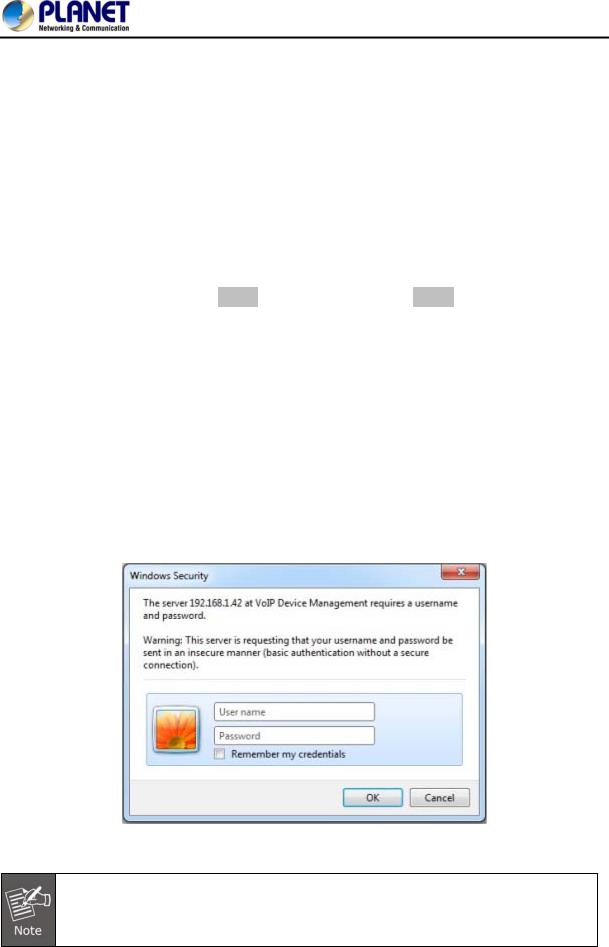
4-Port SIP Internet Telephony Gateway
VGW-400 Series
Chapter 2 Installation Procedure
2.1 Web Login
Step 1. Connect a computer to an LAN port on the VGW-400 series. Your PC must set up to the same domain as 192.168.0.X as the VGW-400 series
Step 2. Start a web browser. To use the user interface, you need a PC with Internet Explorer (version 6 and higher), Firefox, or Safari (for Mac).
Step 3. Enter the default IP address of the VGW-400 series: 192.168.0.1 into the URL address box. Step 4. Enter the default user name admin and the default password admin, and then click Login to
enter Web-based user interface.
(Default IP)
Default WAN IP |
172.16.0.1 |
Default Subnet Mask |
255.255.255.0 |
Default Gateway |
172.16.0.254 |
Default LAN IP |
192.168.0.1 |
Default Login User Name |
admin |
Default Login Password |
admin |
|
|
Login page of the VGW-400 series
For security reason, please change and memorize the new password after this first setup.
20
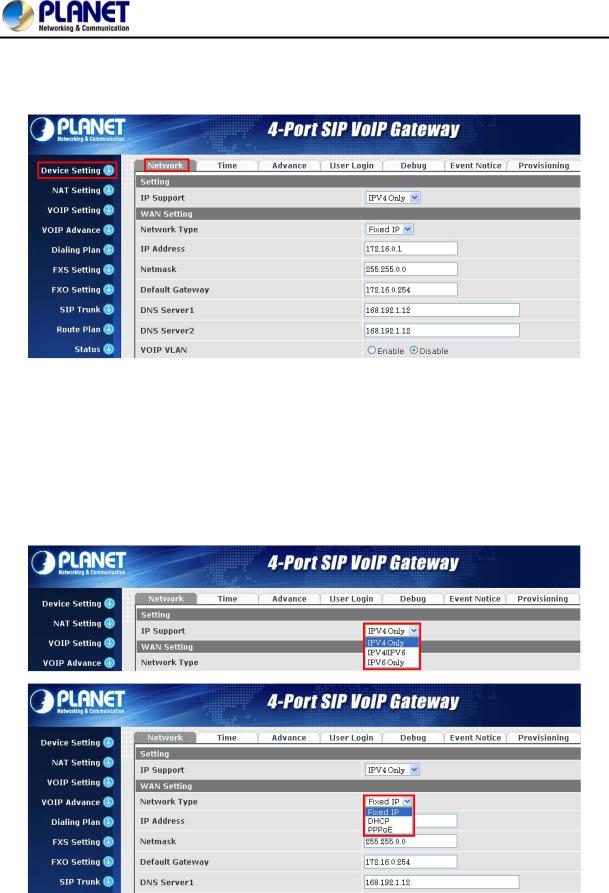
4-Port SIP Internet Telephony Gateway
VGW-400 Series
2.2 Configuring the Network Setting
Step 1. Go to Device Setting → Network
Network setting page
Step 2. Edit your WAN port IP information.
There are three types of IP Support -- IPV4 Only, IPV4 / IPV6, IPV6 Only. There are also three types of WAN port connection -- Static IP, PPPoE (Point-to-Point Protocol over Ethernet) and DHCP. You can find detailed setting process in the user manual.
Selection of IP Support / Network Connection Type
21
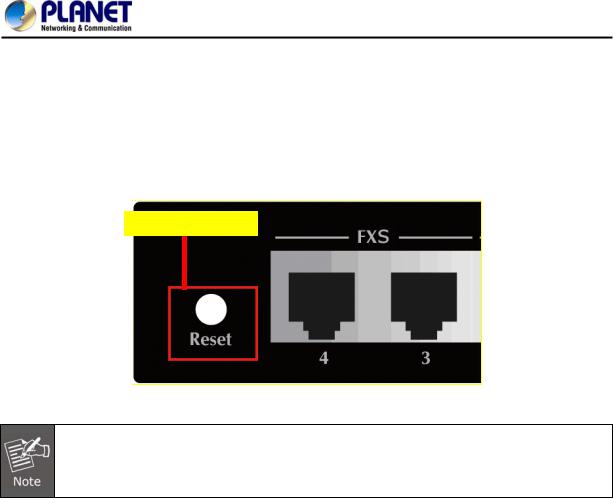
4-Port SIP Internet Telephony Gateway
VGW-400 Series
2.3 Changing IP Address or Forgotten Admin Password
To reset the IP address to the default IP Address “192.168.0.1” (WAN) or reset the login password to default value, press the reset button on the front panel for more than 5 seconds. After the device is rebooted, you can login the management WEB interface within the same subnet of 192.168.0.xx.
Reset Button
After pressing the “Reset” button, all the system data will be reset to default; if possible, back up the config file before resetting.
22
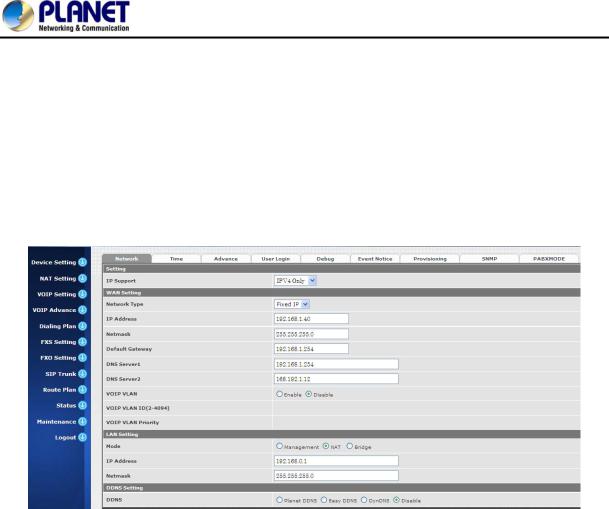
4-Port SIP Internet Telephony Gateway
VGW-400 Series
Chapter 3 Device Setting
From this setting category, all devices related to parameters can be found here.
Network Configuration
3.1 Network Configuration
Figure 2-1 network setting
Parameter Description:
Setting:
zIP Support: IP stack to be supported (IPV6 and IPV4 or IPV6 or IPV4 only)
WAN Setting:
1 |
Network Type |
Support “Fixed IP”; ”DHCP”; ”PPPoE” |
|
|
|
|
|
2 |
IP Address |
IPV4 address |
|
|
|
|
|
3 |
Net mask |
IPV4 network subnet mask |
|
|
|
|
|
4 |
Default Gateway |
IPV4 Default gateway |
|
|
|
|
|
5 |
DHCP Tag (60 is |
Input Vendor class identifier or not. |
|
optional) |
|||
|
|
||
|
|
|
|
6 |
DHCP Tag (61 is |
Input Client identifier or not. |
|
optional) |
|||
|
|
||
|
|
|
|
7 |
IPV6 Network Type |
Auto configuration or manual configuration |
|
|
|
|
23

|
|
|
4-Port SIP Internet Telephony Gateway |
|
|
|
|
VGW-400 Series |
|
|
|
|
|
|
|
8 |
IPV6 IP Address |
IPV6 address |
|
|
|
|
|
|
|
9 |
IPV6 IP Gateway |
IPV6 default Gateway |
|
|
|
|
|
|
|
10 |
IPV6 IP Prefix Length |
IPV6 prefix length |
|
|
|
|
|
|
|
11 |
DNS Server 1 |
Primary DNS Server IP network |
|
|
|
|
|
|
|
12 |
DNS Server 2 |
Secondary DNS Server IP network |
|
|
|
|
|
|
|
|
|
Enable VoIP VLAN or not. When enable VoIP VLAN, the WAN |
|
|
13 |
VoIP VLAN |
port can be only accessed by VLAN. If it is required to manage |
|
|
the VGW Gateway series, administrator can use LAN port to |
|
||
|
|
|
|
|
|
|
|
access this gateway instead. |
|
|
|
|
|
|
|
14 |
VoIP VLAN ID (2-4096) |
VLAN ID range to be used |
|
|
|
|
|
|
LAN Setting:
1 |
Management Mode |
This LAN port is used for management purposes, not used for |
|
register to SIP Server or data/voice routing. |
|||
|
|
||
|
|
|
|
|
|
DHCP function on the LAN port. The LAN port functions as a |
|
|
|
DHCP server. Network devices connected to them will be |
|
2 |
NAT Mode |
assigned one IP address according to DHCP server IP range. |
|
|
|
(Please refer to the command of “NAT setting” on the left side for |
|
|
|
how to define DHCP IP address.) |
|
3 |
IP Address |
IPV4 address |
|
|
|
|
|
4 |
Net Mask |
IPV4 network subnet mask |
|
|
|
|
|
5 |
Bridge Mode |
In this mode, both WAN and LAN ports are configured to |
|
Switch/Hub features. LAN port has access to WAN port directly. |
|||
|
|
||
|
|
|
DNS Setting:
1 |
DDNS |
It supports Planet DDNS, Easy DDNS and DynDNS or disables |
|
the DDNS feature. |
|||
|
|
||
|
|
|
|
2 |
Domain Name |
Input your domain name |
|
|
|
|
|
3 |
User Name |
Input your user name |
|
|
|
|
|
4 |
Password |
Input your password |
|
|
|
|
24
